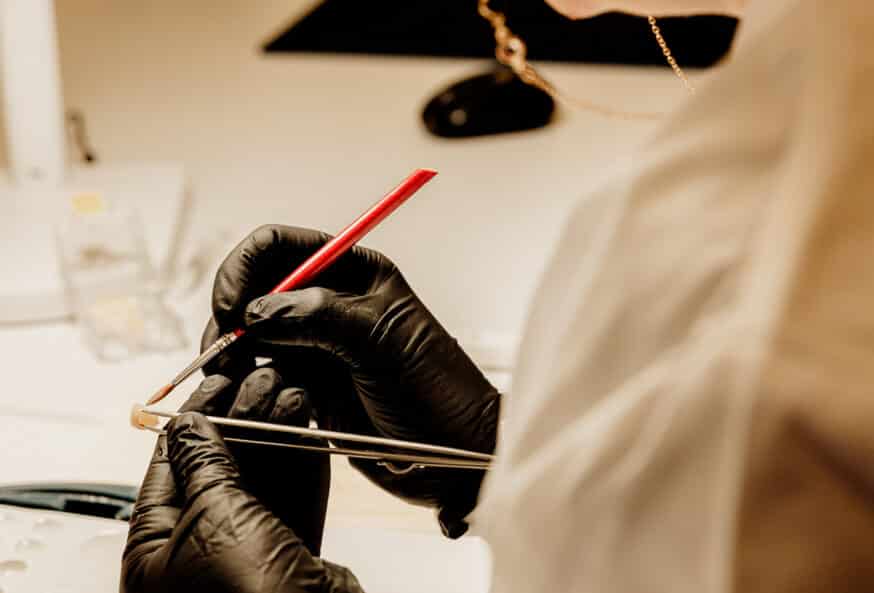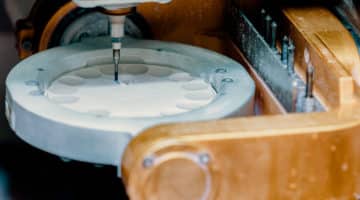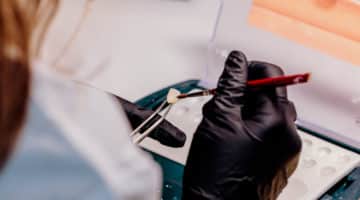Zirconia is a robust dental material you can use to customize crowns and partials. With its improved aesthetics, colors, and translucency, clinical use for zirconia crowns is increasing all the time. Of course, before you can place zirconia restorations, you need to prep for them, and getting zirconia crown prep right is paramount to a successful restoration.
However, the precision required in a prep for zirconia crown—as well as the zirconia crown prep dimensions—make getting it right trickier than with other restorative materials. So, we developed this comprehensive guide to zirconia crown preparation that can deliver the best possible patient outcomes and experience with your crown and bridge restorations.
The importance of tooth preparation for zirconia crowns
In addition to design, crown preparation for a zirconia crown is critical to enjoy the advantages of zirconia crowns, like durability, biocompatibility, chemical and dimensional stability, and fracture resistance. Zirconia crowns have preparations similar to other materials’ prep, but need extra care because of the complexity of the entire procedure.
Knowing the proper steps for zirconia restoration design and crown preparation optimizes the longevity of the restoration. Also, using the appropriate tools and technology for prep and seating is essential. Therefore, training, technology, and experience in these areas will improve procedural accuracy and extend the life of the zirconia crown.
Explore Dandy Zirconia Crowns
Dandy offers a variety of different dental zirconia crowns with various strengths, durability, and aesthetics.

Zirconia crown prep dimensions & guidelines
The zirconia crown prep dimensions depend on the natural tooth’s location. Visibility and continuity are essential for zirconia crown prep, whether anterior or posterior crowns. The guidelines and specific incisal edge reduction and clearance measurements are altered according to the crown’s location.
Tooth prep can be a complex process. However, using intraoral scanners and digital modeling facilitate a comparative evaluation and the prep process. Prosthetic restoration margins are essential factors in clinical success. Industry literature indicates a preference for supragingival preparation.
Preparing a tooth for a zirconia crown needs impeccable marginal finishing lines. There are two types: a vertical finishing line without a defined margin, known as feather edge preparation, or a sharp horizontal line with a clear finishing line, also known as a chamfer.
Zirconia crown prep for anterior crowns
Anterior zirconia crown prep requires closer attention to the following elements.
Clearance: Leave at least 0.3 mm of space to accommodate the crown’s wall thickness. Additionally, you’ll need to account for an incisal reduction of 1 to 1.5 mm or 1.8 to 2.0 mm.
Circumferential chamfer: The continuous circumferential chamfer should be visible and continuous. The gingival margin needs a reduction of at least 0.5mm.
With more visibility, the anterior crown necessitates prepping the tooth structure with an angle of approximately 5°, with no beveling. The incisal edge should be rounded using a football diamond bur to reduce the incisal edges of the crown facing the tongue, making it slightly concave.
Zirconia crown prep for posterior crowns
In the posterior of the mouth, zirconia crown prep involves many of the same considerations that apply to anterior crowns, plus a few aspects that are specific to the back of the mouth. This is because the posterior section of the mouth is a startlingly different environment than the front of the mouth, as it shoulders more mastication responsibility and can be more vulnerable to cavities.
When prepping for posterior zirconia crowns, pay close attention to the below.
Clearance: Posterior crowns are slightly thicker than anterior crowns and thus need more room to accommodate their size. Approximately 0.5mm of space is recommended. The proper occlusal reduction is between 1 and 1.5mm or 1.5 to 2mm.
Circumferential chamfer: Visibility and continuity are key when it comes to zirconia crown prep. For posterior crowns, provide for a 0.5m reduction at the gingival margin. Additionally, posterior crowns should be slightly tapered between 4° and 8°.
Like their anterior counterparts, it’s recommended that you avoid beveling posterior crowns. The edges of the crown surfaces that come into contact with food should be slightly rounded.
Patient assessment for zirconia crown preparation
For optimal success of a zirconia crown restoration, there are needed assessments. Answer the following:
What type of crown is necessary?
What is the location of the crown?
What kind of crown is required?
What is the health of existing abutment teeth?
What are the patient’s aesthetic goals?
The last assessment depends on whether it is for an anterior or posterior crown. We shall give more detail on this later.
Secondly, there are impressions of the patient’s teeth. The usual method of capturing impressions was trays and impression material, such as putty. While they did capture the patient’s teeth contours, PVS lacked exactness and speed of use. Consider all the necessary steps:
- Taking impressions with PVS molds
- Creating stone models
- Shipping the models to a lab
When models arrive at a traditional dental laboratory, additional time is needed for the following:
- Scanning the models
- Designing the crown
- Printing or milling new models for fit
- Sending the crown back to your practice
This process may take 12 to 15 days for most labs to complete. However, some labs may take more than three weeks. That does not include adjustment time or reorders.
Digital impressions for zirconia crowns
Improved technology, like digital scanners, makes dentistry easier, cost-effective, and more efficient. Even complex procedures like the denture process and the zirconia prep process have these advantages when digital versus traditional impressions.
There are advantages to digital dental crown prep. Digital intraoral scanners provide scans of both the original and prepped tooth quickly. Lab software can copy the preexisting anatomy of the original tooth.
The advantages to digital impressions, besides time and money, are providing patients with a dental crown prep process that is faster and more accurate. Additionally, there is an average five to eight-day turnaround time. But envision the patient experience. There is less time in the chair and no gooey gag-worthy impression material. That is an experience the patient will remember and talk about.
A typical process includes:
- The patient gets an intraoral scan.
- The clinician sends the digital scan electronically to the dental lab.
- The lab designs the patient’s restoration using the digital impression and design software.
- The lab sends the restoration to the practice, where it fits the patient the first time the clinician seats it.
The other benefit of intraoral scanners is they are multi-use. They can cover the denture process, orthodontic appointments, and dental implants optimizing all workflows.
Limiting factors for zirconia crown preparation suitability
Knowing what to do is an excellent start to producing appropriate preps for zirconia crowns. Next, it’s a good idea to know what not to do when prepping for a zirconia crown. These include:
- Do not include undercuts or gutter preparations. Be sure to look for undercuts in the gingival third; this area has undercuts most often, especially in long preparations.
- Avoid parallel wall preparations. Instead, the prep walls should be angled the appropriate amount depending up on where they are in the patient’s mouth.
- Skip sharp incisal edges. Use a football diamond to round the incisal edge of the crown on the lingual, making it concave. Occlusal edges should also be rounded, too.
Monolithic restorations
Solid or monolithic zirconia is favored for posterior crowns. The difference will be the zirconia state. Non-sintered zirconia, or green state, is soft, fragile, and moist. Pre-sintered is the process most manufacturers use. The pressed zirconia blocks are “sintered” at about 65% of the final sintering temperature. At this stage, the zirconia is still soft for milling and dry for easy shrinkage factor calculation. The pre-sintered zirconia state is more robust and has a predictable uptake of the coloring solution.
Recently, layering techniques have advanced creating zirconia crowns that are stronger due to the substructure. A layered crown does not chip or crack on the incisal surface of the tooth or the occlusal biting edge or the top of molars. The increased structural durability from pre-sintered or layered zirconia helps patients with a heavy bite, grind their teeth, or present a limited occlusal clearance.
Crowns using solid zirconia need an occlusal anatomy depth of 1.0 to 1.5 mm with functional cusp tips reduced by 1 to 1.5 mm and a 6° to 8° along the axial wall.
Layered restorations
In some cases, clinicians want to use layered zirconia to improve aesthetics. This type of zirconia uses ceramic layering to increase translucency and opalescence, which makes the patient’s smile look more realistic.
Layered zirconia can be made from layers of other types of zirconia that produce improved aesthetics, or with other materials, like porcelain. However, on the biting surface where durability is essential, the material is still full zirconia.
Porcelain Fused to Zirconia (PFZ) Crowns have the best of both materials. PFZ crowns have the aesthetics of porcelain on the outside with the strength of zirconia on the inside. We consider it the go-to alternative material for Porcelain Fused to Metal (PFM) crowns.
Some things you might not realize about PFZ include:
- It enjoys higher aesthetics than lithium disilicate (eMax).
- It is stronger than a PFM.
- It uses the same prep margins as monolithic zirconia, although with slightly less flexural strength.
Chairside adjustments for zirconia crowns
Any roughness of the surface can be polished to an exceptionally smooth surface with a fine diamond bur. Do not use a heavy hand in the reduction or excessive heat. This can lead to micro-factures.
Crown preparation avoidances
The factors that make tooth prep suboptimal for zirconia restorations.
- Undercuts
- Gutter preparation
- Parallel wall preparations
- Sharp incisal
Be attentive to these situations, know the rules of zirconia crown prep, and follow them closely to avoid errors.
Why is tooth preparation for crowns important?
Proper zirconia crown preparation is crucial to a comfortable and correct prosthodontic fit. Precision fitting restorations, e.g., a zirconia dental crown, can impact how your patient’s mouth feels and operates, influencing their experience. It also affects the patient’s oral health. If an improper fit and excess cement are used, it can lead to issues. The wrong fit risks can include:
- Cavities and tooth decay
- Gum disease
- Core teeth fracture
- Tooth sensitivity
- Jaw pain
A zirconia crown prep done well will create a resilient crown and prevent complications. With modern technology and tools, there is no guesswork and fewer errors. Digital scanners aid in workflows providing a streamlined, user-friendly process that reduces the number of translations from impression to design.
There are definite advantages to digital dentistry.
How Dandy supports zirconia crown preparation
Crown and bridge restorations have had significant advancements in quality and efficiency in the last decade. As one of its newest materials, zirconia requires taking the proper steps during preparation to seat crowns and bridges to deliver more beautiful smiles than ever.
Beautiful smiles also need a good dental lab partner. We invite you to try Dandy as your next crown and bridge lab. Our process improves patient experience, bolsters your practice output, and streamlines every aspect of how you practice oral healthcare.
We make it easier than ever to go digital with your dentistry and dental restorations. Our platform is the first of its kind and serves as a complete, fully-digital dental lab that makes digital dentistry easy, convenient, and powered by the speed of the internet.
Ready to find out how you can save time and money by going digital? Meet Dandy today and learn more.
Sources:
International Journal of Oral Science. Surface roughness of zirconia for full-contour crowns after clinically simulated grinding and polishing. https://www.ncbi.nlm.nih.gov/pmc/articles/PMC5153586/
AVF Dental Group. Zirconia Crowns: Advantages and Disadvantages of Zirconia Crown. https://www.avfdentalgroup.com/zirconia-crown-advantages-and-disadvantages-of-zirconia-crown/#
International Journal of Dentistry. Three-Dimensional Accuracy of Digital Impression versus Conventional Method: Effect of Implant Angulation and Connection Type. https://www.ncbi.nlm.nih.gov/pmc/articles/PMC6008832/
Journal of Materials Research and Technology. Zirconia in dental prosthetics: A literature review. https://www.sciencedirect.com/science/article/pii/S2238785419300419#sec0040
Acero Crowns. How Many Times Can Posterior Crowns Be Replaced? https://www.acerocrowns.com/posterior-crowns
Science Direct. Influence of Preparation Design On the Quality of Tooth Preparation in Preclinical Dental Education. https://www.sciencedirect.com/science/article/pii/S1991790216300526#
Dentistry 33. Chamfer vs. Feather Edge for a Single Zirconia Crown https://www.dentistry33.com/clinical-cases/prosthodontics/318/chamfer-vs-feather-edge-for-a-single-zirconia-crowns.html#:~:text=To%20prepare%20a%20tooth%20for,finishing%20line%20(knows%20aschamfer).
European Journal of Oral Sciences. Effect of margin design on fracture load of zirconia crowns https://onlinelibrary.wiley.com/doi/full/10.1111/eos.12593
City Smiles of St. Louis. Does Your Crown Fit Right? https://www.citysmilesstlouis.com/blog/does-your-crown-fit-right/#
DiTolla, DDS, FAGD, M. “Common Preparation mistakes that cost you money (2015).” Available at: https://www.dentaleconomics.com/science-tech/article/16391662/common-preparation-mistakes-that-cost-you-money (Accessed: 11 October 2023).
Want more information on the latest materials being used in dentistry?
We send emails on Tuesdays. Keep an eye out for the next one!



